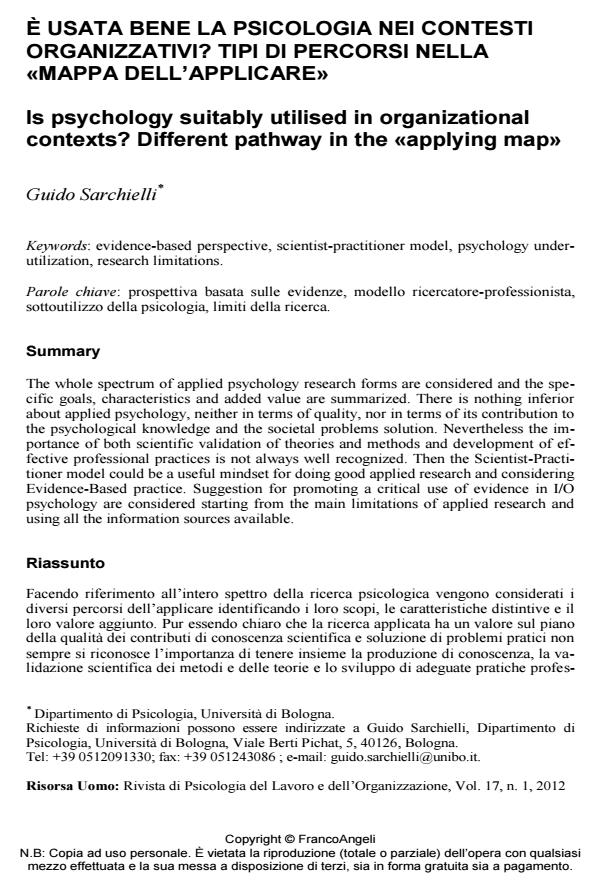È usata bene la psicologia nei contesti organizzativi? Tipi di percorsi nella "mappa dell’applicare"
Titolo Rivista RISORSA UOMO
Autori/Curatori Guido Sarchielli
Anno di pubblicazione 2014 Fascicolo 2012/1 Lingua Italiano
Numero pagine 7 P. 11-17 Dimensione file 612 KB
DOI 10.3280/RU2012-001003
Il DOI è il codice a barre della proprietà intellettuale: per saperne di più
clicca qui
Qui sotto puoi vedere in anteprima la prima pagina di questo articolo.
Se questo articolo ti interessa, lo puoi acquistare (e scaricare in formato pdf) seguendo le facili indicazioni per acquistare il download credit. Acquista Download Credits per scaricare questo Articolo in formato PDF

FrancoAngeli è membro della Publishers International Linking Association, Inc (PILA)associazione indipendente e non profit per facilitare (attraverso i servizi tecnologici implementati da CrossRef.org) l’accesso degli studiosi ai contenuti digitali nelle pubblicazioni professionali e scientifiche
The whole spectrum of applied psychology research forms are considered and the specific goals, characteristics and added value are summarized. There is nothing inferior about applied psychology, neither in terms of quality, nor in terms of its contribution to the psychological knowledge and the societal problems solution. Nevertheless the importance of both scientific validation of theories and methods and development of effective professional practices is not always well recognized. Then the Scientist-Practitioner model could be a useful mindset for doing good applied research and considering Evidence-Based practice. Suggestion for promoting a critical use of evidence in I/O psychology are considered starting from the main limitations of applied research and using all the information sources available.;
Keywords:Prospettiva basata sulle evidenze, modello ricercatore-professionista, sottoutilizzo della psicologia, limiti della ricerca.
- Baughman, W. A., Doresey, D. W., & Zarefsky, D. (2011). Putting evidence in its place: A means not an end. Industrial and Organizational Psychology: Perspectives on Science and Practice, 4, 62-64. DOI: 10.1111/j.1754-9434.2010.01297.
- Briner, R. B., & Rousseau, D. M. (2011). Evidence-Based I-O Psychology: Not there yet but now a little nearer? Industrial and Organizational Psychology, 4, 76-82, DOI: 10.1111/j.1754-9434.2010.01287.x.
- Brutus S., Gill, H., & Duniewicz, K. (2010). State of science in industrial and organ izational psychology: A review of self-reported limitations. Personnel Psychology, 63, 907-936. DOI: 10.1111/j.1744-6570.2010.01192.
- Dovidio, J. F., & Esses, V. M. (2007). Psychological research and public policy: Bridging the gap. Social Issues and Policy Review, 1, 5-14. DOI: 10.1111/j.1751-2409.2007.00002.
- Drenth, P. J. D. (1996). Psychology as a science: Truthful or useful? European Psy chologist, 1(1), 1-13. DOI: 10.1027/1016-9040.1.1.
- Drenth, P. J. D. (2008). Psychology: Is it applied enough? Applied Psychology: An In ternational Review, 5(3), 524-540. DOI: 10.1111/j.1464-0597.2008.00337.
- Drenth, P. J. D., & Heller, F. A. (2004). The dangers of research myopia in work and organisational psychology: A plea for broadening and integration. Applied Psychol ogy: An International Review, 53(4), 599-613. DOI: 10.1111/j.1464-0597.2004.00191.
- Drenth, P. J. D., Thierry, H., & de Wolff, C. J.(Eds.). (1998). Handbook of work and organizational psychology: Introduction to work and organizational psychology, (2 ed.). Hove: Psychology Press.
- Schönpflug, W. (1993). Applied psychology: Newcomer with a long tradition. Applied Psychology: An International Review, 42, 5-66. DOI: 10.1111/j.1464-0597.1993.tb00715.
- Thayer, A. L., Wildman, J. L., & Salas, E. (2011). I-O Psychology: We have the evi dence: We just don’t use it (or care to). Industrial and Organizational Psychology, 4, 32-35.
- van Maanen, J. Dabbs, J. M., & Faulkner, R. R. (Eds.). (1982). Varieties of qualitative research. Beverly Hills, CA: Sage.
Guido Sarchielli, È usata bene la psicologia nei contesti organizzativi? Tipi di percorsi nella "mappa dell’applicare" in "RISORSA UOMO " 1/2012, pp 11-17, DOI: 10.3280/RU2012-001003